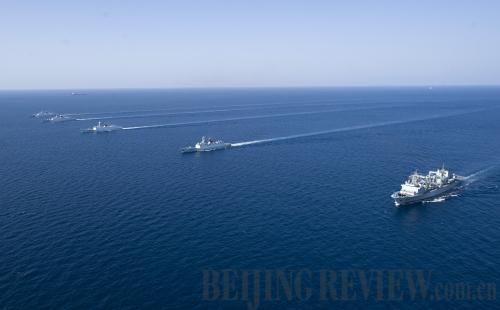|
 |
|
MARINE GUARDIAN: Chinese Navy vessels on an escort mission in the pirate-infested Gulf of Aden (FAN JUNWEI) |

For many years, Western countries have criticized China for its military modernization and for a perceived lack of transparency. The West's nitpicking over China's military transparency aims to contain this emerging power. But it also shows that Western countries have blind spots about Chinese philosophy. To comprehensively understand China, they still have much to do to make up their knowledge of Chinese history and culture.
It is insufficient to discuss China's military transparency without looking at Chinese history and culture. When evaluating whether a country constitutes a threat, one should look at not only its military strength but also its domestic and foreign policies, including its defense policy. What is the most important is the transparency of intention. China consistently pursues a defensive military policy and an independent foreign policy of peace. It has no intention to challenge others, let alone to threaten others. In this sense, China has maintained the openness of its military strategy. Therefore, the Chinese military is transparent on a strategic level.
China has been keeping a moderate and defensive posture in its military philosophy. Judging Chinese military transparency with Western standards is neither suitable nor sensible.
For the West, Chinese military expenditure has always been an enigma. Though China is active in participating in international military transparency mechanisms and publishes national defense white papers regularly, Western countries have responded with skepticism and mistrust.
Military transparency is always relative. There is no absolute transparency. No country can make its military completely and fully transparent. For instance, few people know exactly the spending of the United States on its nuclear weapons research and development. The development project of the U.S. F-117 stealth fighter was also top secret, not only for the consideration of technical security, but also to ensure the fighter would be a trump card for U.S. forces. The F-117 later played a major role in the Gulf War in 1991 and the U.S. invasion of Panama in 1989.
In the first two decades after the adoption of the reform and opening-up policy, China kept military expenditures low. It was not until the late 1990s that the country began to increase its military budget by double digits. One of the reasons was to safeguard national unity, given the mounting threats of "Taiwan independence" forces as well as non-traditional security problems in the 1990s. Also, changes in modern warfare demand the modernization of the military. Promoting the use of advanced information technology in the People's Liberation Army requires a huge budget. China's military expenditure has been rising swiftly since 1998, leading to improvements in soldiers' living conditions and weaponry systems despite inflation. But China's military spending is still not high. In recent years, the ratio of China's military budget to the country's GDP has stood at 1.5 percent on average, while the international level is 3 percent. Also, China spends less on the military than most other countries on a per-capita basis.
China's military budget is included in the government budget draft and is submitted to the National People's Congress, the country's top legislature, for discussion and approval. The whole process is transparent. To reduce the suspicions of other countries, China has published white papers on national defense every two years since 1998. The white papers detailed China's military spending, including living expenses, operation and maintenance expenses and equipment expenses. They provided a timely elaboration on the latest information concerning China's national defense policy, military expenditure, and development of troops and installations.
In 2007, China joined the UN Standardized Instrument for Reporting Military Expenditures. It has since made public its military spending according to UN requirements, which shows that China is committed to enhancing military transparency and promoting military trust with other countries.
China's nuclear arsenal is another concern for Western countries. They are curious about how many nuclear bombs China has, where the bombs are deployed and how China will modernize its nuclear weapons. However, for China, which keeps only a minimal nuclear deterrent, making its nuclear arsenal known to the public will undoubtedly invalidate that deterrent.
| 